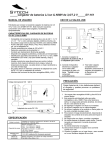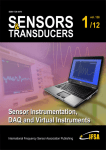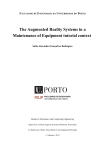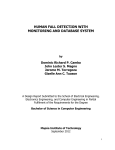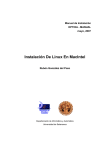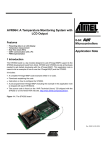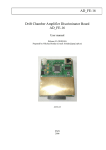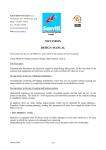Download ABBRES Audio Remote Control System USER MANUAL INTERNAL
Transcript
ABBRES Audio Remote Control System USER MANUAL ATTENTION ! : - Please read carefully each part of this manual. - Designers of this kit decline any responsibility of improper use of this system - When the board has to be connected to the 220V or 110V high voltage, boards need to be correctly insulated to avoid risk of electric shock. Insulation missing of the boards could cause dangerous consequences to the people. - System must not to be exposure to wet or rain or any other kind of liquids. Moreover need to be correctly ventilated during his working. - Wired connections between the two boards and external power supply have to be correctly done using insulated wires. - Boards and components on the boards need to be not reached from people during they are working. - If points above are not observed system could be damaged or it could cause damages to the people. Audio Remote Control System ABBRES is made of two electronic boards, an infrared remote control unit, a display LCD back-lighted and a IR sensor diode to receive signals from remote unit. One of the two boards, we call INPUT BOARD, handles commutation audio input signals on selecting audio input source (CD, Tape, Aux, …) The other board, we call MAIN BOARD, handles INPUT BOARD , motorized potentiometer, infrared IR diode, LCD display unit, a relay to switch on/off external preamplifier or power amplifier. System is equipped with screw terminal blocks to ease the connections. Each screw terminal block or connector is marked by a label on the top of the PCB for each board. This manual refers to these labels to explain how you do all the connection. INTERNAL SYSTEM CONNECTIONS : - CONNECTING INPUT BOARD AND MAIN BOARD To connect INPUT BOARD to the MAIN BOARD you need to use the 3-wired terminals block on both boards marked with char A,B,C. Terminal A of a board has to be connected to the relative terminal A of the other board. The same for terminal B and C. Connection scheme is illustrated in the table below. Terminal block INPUT BOARD A B C Terminal block MAIN BOARD Æ Æ Æ A B C INPUT BOARD 1 MAIN BOARD MAIN BOARD - CONNECTING MAIN BOARD WITH MOTORIZED POTENTIOMETER (ALPS) Connector for motorized potentiometer is placed on the MAIN BOARD and it’s marked MOTOR. As on the market you can find several motorized potentiometers with different polarities it has not been marked any polarity that can be found swapping the two wired connections. It is possible easily verify if the polarity is correct, rising volume by the remote control unit (pushing VOL+ key) and checking that potentiometer increments his position clockwise. If it’s not, you need swap the two wired connections. MOTOR MAIN BOARD 2 - CONNECTING MAIN BOARD WITH IR RECEIVER SENSOR DIODE Receiver IR diode is an integrated circuit with 3 pins and his part number is TSOP1736 produced by VISHAY Telefunken (also TSOP1836 is full compatible). Together with this manual it’s provided the pin-out sheet of the TSOP1736. This TSOP1736 has to be connected in a 3 pins connector placed at the center of the MAIN BOARD using 3 insulated wires, if possible twisted it’s better. We suggest you use 3 wires with 3 different colors to avoid any confusion. ATTENTION! IT’S MANDATORY TO CORRECTLY CONNECT THE PINS OF THE IR DIODE TO THE 3-PINS CONNECTOR ON THE MAIN BOARD OTHERWISE IR DIODE COULD REMAIN PERMANENTLY DAMAGED. The connector is placed round to the center of the main and it’s marked with the labels VCC GND and IR at the ends of the 3 pins. Following it’s illustrated the correspondence between IR TSOP1736 pins (called GND, Vs , OUT in his datasheet), and the pins of the MAIN BOARD connectors. IR DIODE pin GND Vs OUT Æ Æ Æ 3-pins on MAIN BOARD GND VCC IR IR DIODE MAIN BOARD - CONNECTING MAIN BOARD WITH LCD DISPLAY The LCD display has a 1x16 row connector and it has to be connected to the relative connector (1x16 row pins) on the MAIN BOARD by a dedicated cable. Pin number 1 on both row connectors (MAIN BOARD and LCD display) have to be linked together. Connection can be performed by a flat cable (typically used for IDE hard-disk provided in the kit). The flat cable is a 34pins (2x17 row pins) so you will use only 1x16 row pins and need to align the same ends of the cable to the LCD display and board connector. Example of connection in the following picture: This row is not used LCD FLAT CABLE 34 pins (17x2 row pins) This row is not used MAIN BOARD Pin 1 Pin 1 16 pins used 16 pins used 3 EXTERNAL CONNECTIONS TO THE SYSTEM: INPUT BOARD - CONNECTING INPUT BOARD TO THE POWER SUPPLY (NOT PROVIDED) The INPUT BOARD has to be supplied in a range [7V..9V]. Non stabilized voltage is permitted. Positive voltage of the supply has to be connected to the side of the terminal block labeled +VCC while the ground has to be connected to the side of the terminal block with label GND. ATTENTION! PROVIDING A VOLTAGE >9V THE REGULATOR AND THE RELE’ CAN BE DAMAGED BY OVERHEATING. PROVIDING A VOLTAGE <7V IT’S NOT GUARANTEED THE RELAY STABILITY. POWER SUPPLY NEEDS TO PROVIDE AT LEAST 500mA AS TWO RELIES ARE WORKING AND POTENTIOMETER NEED 150 mA. SUPPLY INPUT BOARD - CONNECTING OUTPUT ANALOGUE AUDIO SIGNAL OF THE INPUT BOARD Output audio signal (left and right), that goes to the input of the amplifier, is on INPUT BOARD by a 4 wired terminal block as following: Label RO Æ output right channel Label MR Æ ground right channel Label LO Æ output left channel Label ML Æ ground left channel OUTPUT SIGNAL INPUT BOARD 4 - CONNECTING INPUT ANALOGUE AUDIO SIGNAL OF THE INPUT BOARD The 6 inputs analogue stereo (coming from an audio source like a CD player) on the INPUT BOARD are visible in 6 zone marked off by a rectangle shape. Each zone is related to a single source and has 4 terminal holes that you have to use to connect the source to the system. The terminals are in this case the holes on PCB of the INPUT BOARD and they admit only wires to be soldered. Terminals related to a generic input are following: Label R Æ Label M Æ Label L Æ Label M Æ input right channel ground right channel input left channel ground left channel INPUT SIGNAL INPUT BOARD - CONNECTING ANALOGUE AUDIO SIGNAL TO THE RELATIVE INPUT AS SHOWN IN THE LCD DISPLAY iPOD PHONO AUX DVD TUNER 5 CD MAIN BOARD - CONNECTING BUTTONS TO THE MAIN BOARD Buttons (optional) to command the system have to be connected by 4 pairs of small 2-wire terminal block on the MAIN BOARD. As buttons do not have polarity, it’s not marked any polarity label on these terminal blocks, while instead it’s marked the functionality for each button: label VOL+ label VOLlabel INPUTS label PWR Æ rise volume Æ decrease volume Æ input selection Æ power-on/off of the amplifier (by a rele’ on the MAIN BOARD) TO BUTTONS MAIN BOARD - CONNECTING MAIN BOARD TO THE POWER SUPPLY (NOT PROVIDED) The MAIN BOARD need a power supply in the range [7V..9V]. Not stabilized voltage is permitted. MAIN BOARD - SUPPLY CONNECTING MAIN BOARD TO THE POWER SUPPLY OF THE PREAMPLIFER OR POWER AMPLIFIER THAT NEED TO BE CONTROLLED (SWITCH ON/OFF) ATTENTION! WORKING WITH HIGH VOLTAGE 220V or 110V ALL CONNECTIONS NEED TO BE CORRECTLY INSULATED AND DONE OTHERWISE THERE IS THE RISK OF ELECTROSHOCK OR FIRE 6 To command switching on/off of an amplifier there is a 2-wired terminal block on the MAIN BOARD that is labeled PWR AMP. This connector is simply like a switch ON/OFF, in series to the power supply line of the amplifier to be controlled PWR AMP MAIN BOARD IMPORTANT! MAXIMUM HANDLING CURRENT FROM THE MAIN BOARD IS 4A THAT NEVER MUST BE OVERCOME. IT’S STRONGLY SUGGESTED TO INSERT A PROPER FUSE AND A MANUAL SWITCH IN SERIES TO THIS CONNECTOR. THIS FUSE SHOULD BE THE ORIGIN SAFE FUSE OF THE AMPLIFIER TO BE CONTROLLED. Fuse and main switch, in the picture below, must be present in the power supply circuit of the amplifier or the system you want to control. Systems absorb more than 4A never must be connected to the MAIN BOARD. See picture below for suggested safe connection. 7 SUGGESTED CONNECTION TO SWITCH ON/OFF A POWER AMPLIFIER MAIN BOARD MANUAL SWITCH FUSE AMPLIFIER or PREAMPLIFIER VOLTAGE SUPPLY (220V/110V - 4A MAX) ATTENTION ! -- HIGH VOLTAGE -RISK OF ELECTROSHOCK AND FIRE COPYRIGHT 2008-2009 – AUTHORS PIER PAOLO ABBATE E FABIO RESTIVO – PALERMO – ITALIA. ALL RIGHTS RESERVED. AUTHORS DECLINE ANY RESPONSIBILITY AND COMPENSATION WHAT IT IS WRITTEN IN THIS MANUAL. CONTENT OF THIS MANUAL COULD BE CHANGED AT ANY TIME FROM AUTHORS WITHOUT NOTICE AND IT COULD BE DIFFERENT TO THE SYSTEM IT IS NOW REFERRING. 8








